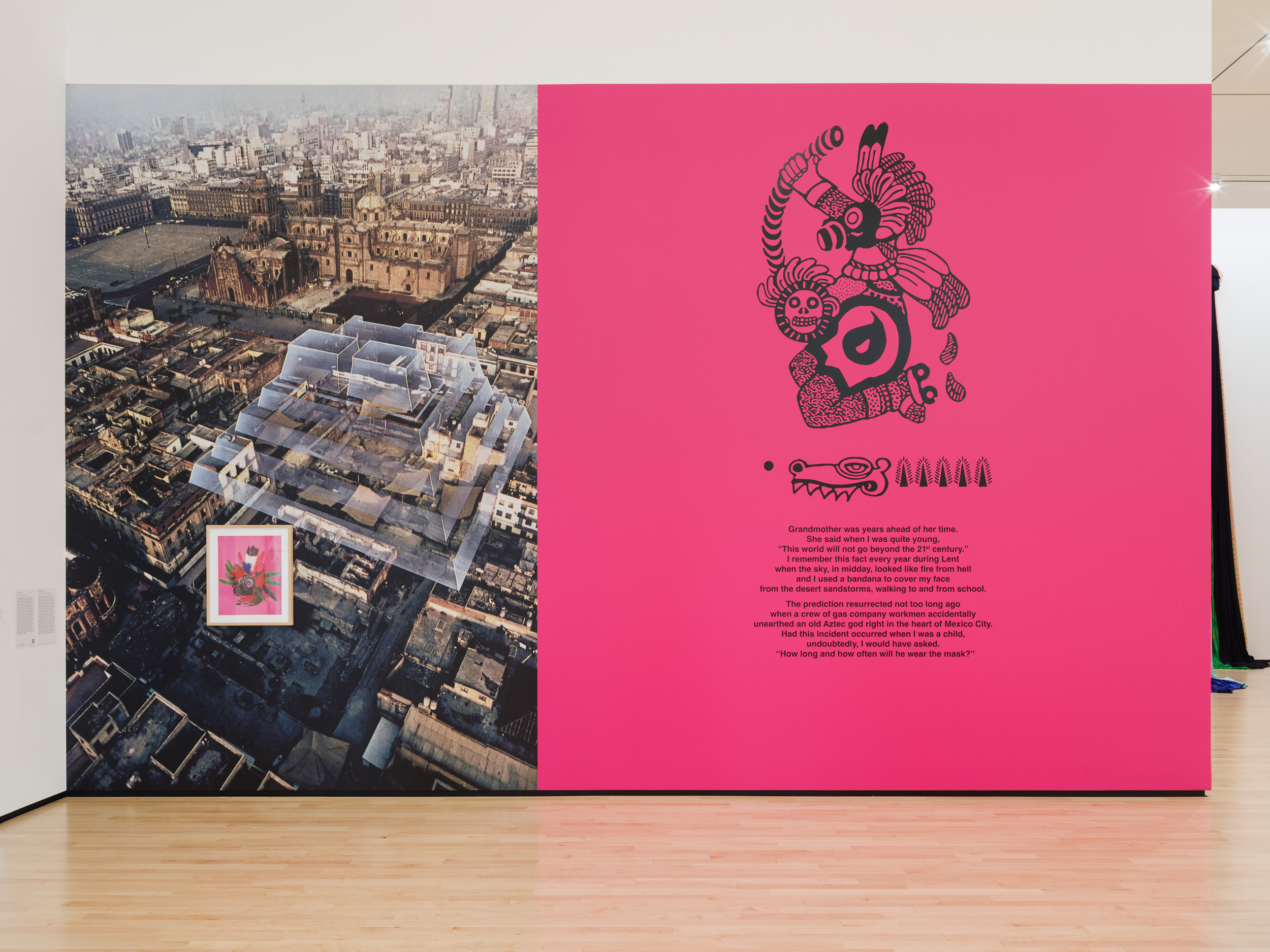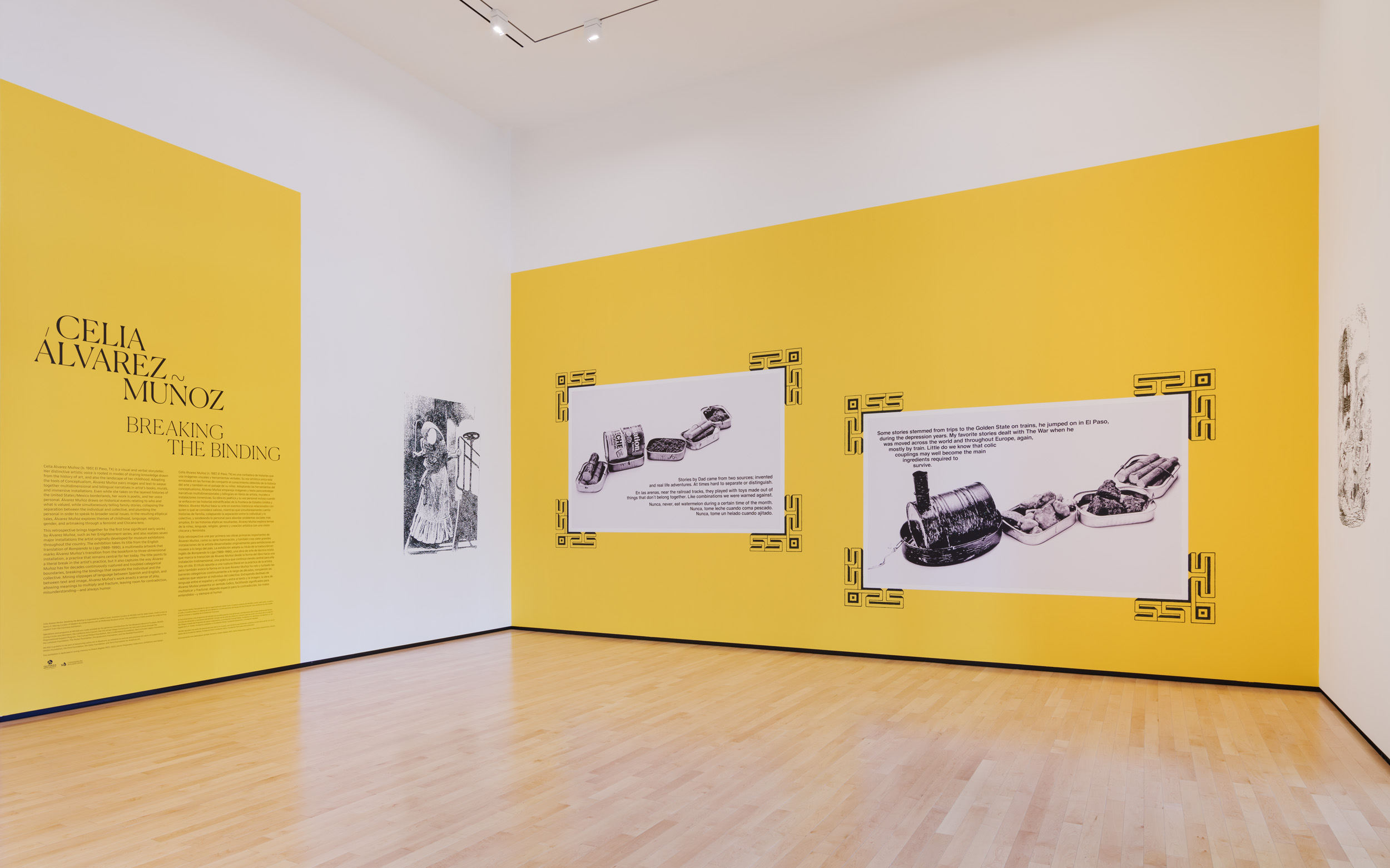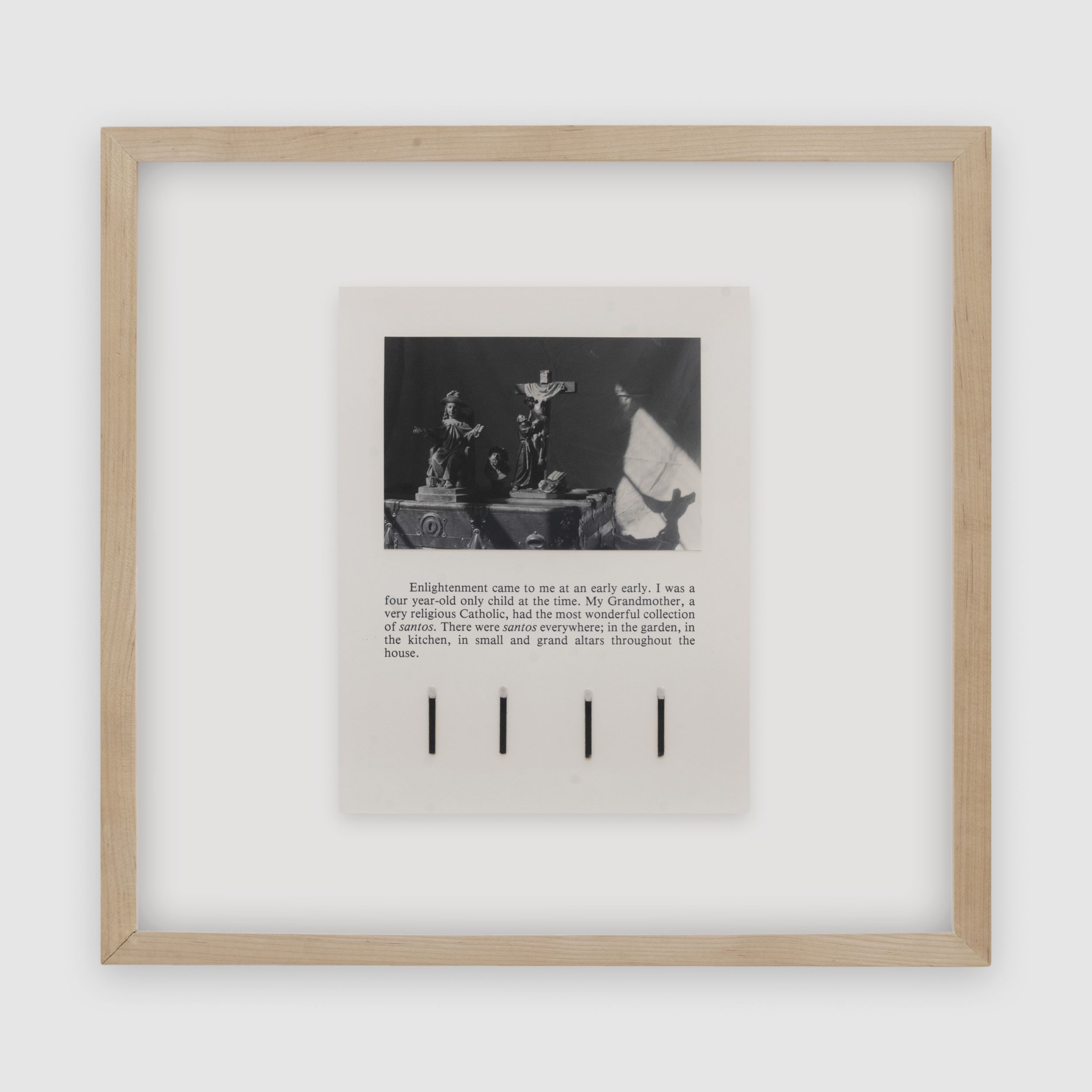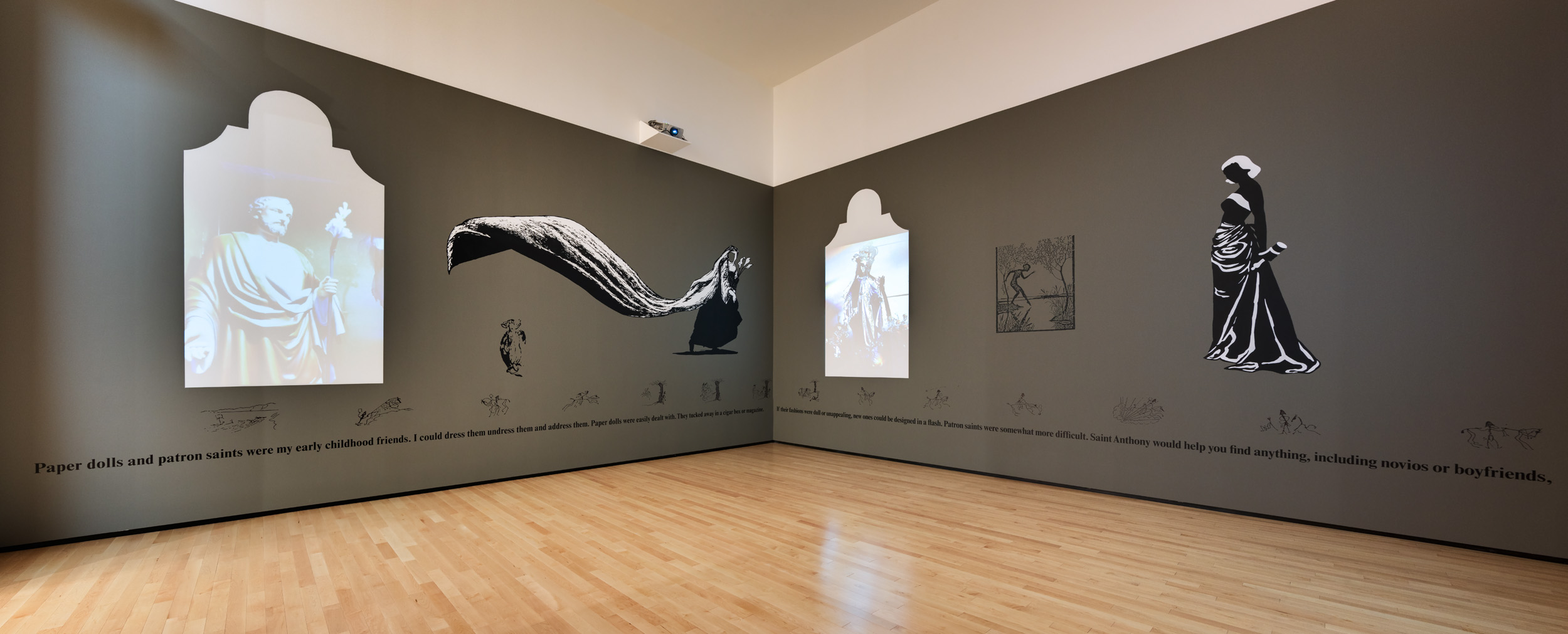Celia Álvarez Muñoz: Breaking the Binding
PDF: Segade, review of Celia Álvarez Muñoz
Curated by: Isabel Casso, Assistant Curator at the Museum of Contemporary Art, San Diego, and Kate Green, Chief Curator and Nancy E. Meinig Curator of Modern and Contemporary Art, Philbrook Museum of Art.
Exhibition schedule: Museum of Contemporary Art, San Diego, March 16–August 13, 2023; University Art Museum, New Mexico State University, Las Cruces, NM, October 20–March 9, 2023; Philbrook Museum, Tulsa, OK, Summer 2024
Catalogue: Isabel Casso, Josh Franco, and Kate Green, eds., Celia Álvarez Muñoz: Breaking the Binding, exh. cat. San Diego: Radius Books, Museum of Contemporary Art, San Diego, 2023. 224 pp.; 90 illus. Hardcover: $60.00 (ISBN: 9781955161343)
I lifted my hand from my heart during the incantation “una Nación bajo Dios” in a private ritual of resistance. My earliest memories of public education took place in a Spanish-language immersion program at Horton Elementary, a magnet school in San Diego that taught all subjects in Spanish. I was fluent by second grade, when a local TV crew filmed me sitting in a circle singing “De Colores” and reciting the Pledge of Allegiance in Spanish with my palm hovering just above my chest.

That was 1981, the same year Celia Álvarez Muñoz made a performance for a graduate class at North Texas State University. Dressing as her professor, Álvarez Muñoz, then a forty-four-year-old Masters of Fine Art student, gave a parafictional talk on the archeological discovery of a new ancient Aztec deity named Petrocuatl, the god of gasoline. She presented a gas mask adorned with colorful feathers to the class as an artifact. Petrocuatl (fig. 1) later became an installation in which a framed photograph of the mask hangs on a wallpaper reproduction of a page from National Geographic: an aerial view of Mexico City with a phantasmic Aztec pyramid appearing where it would be today if it had not been destroyed by colonization. Next to these layers of “evidence”—one an element of a performance artwork; the other a photograph of historical “fact”—is a pink wall stenciled with an icon of the gas-masked god on roller skates, with a calavera (skull) in hand. It hovers above a text that reads: “Grandmother was years ahead of her time. She said when I was quite young, ‘This world will not go past the 21st Century. . . . The prediction resurrected not too long ago, when a crew of gas company workmen accidentally unearthed an old Aztec god in the heart of Mexico City.” The installation combines a prophetic warning from a reimagined past with collapsing histories and mythologies, both personal and colonial. Petrocuatl questions these very distinctions and the slippages within modes, such as mass media and oral histories, through which these forms of knowledge are transmitted.
As such, Petrocuatl is a story about education, a central theme of Álvarez Muñoz’s retrospective exhibition at the Museum of Contemporary Art, San Diego (MCASD). Taken as whole, the work of Álvarez Muñoz narrates the journey of an individual formed and reformed within institutions that afford movement across contexts. Like the border between the United States and Mexico that Álvarez-Munoz traveled daily as a child, these lines, once drawn, become markers and makers of meaning. Like the space between my hand and my chest, my mouth and my voice, when I refused to invoke “nation” and “god” during the pledge as a child, the work of Álvarez Muñoz cleaves between signs and their significance.
Unlike me, learning Spanish in the San Diego School District, Álvarez Munoz (born in 1937) experienced the opposite kind of education: she had to learn “whiteness” as a means of survival within its systems. These tools she learned were turned toward the tasks of unmasking and unmaking the erasure that occurred as a result of assimilation. In Álvarez Muñoz’s installation Postales (1988), she challenges the primacy of English with phonetic spellings of Spanglish pronunciations on street signs suspended with filament from the ceiling above the viewers’ heads. Thus, “Spruce St.” is conjoined with “Esproos St.” These competing linguistic intersections diverge into multiple directions as the artist conjures a neighborhood, like the one where she was raised, in the displaced white space of the gallery.
Álvarez Muñoz’s retrospective is titled Breaking the Binding, a phrase evoking her forty years of work that build on the tactics unfolding in her early artist’s books. The exhibition, organized with great attention to design and didactics by curators Isabel Casso and Kate Green, emphasizes the artist’s use of image and text as means of exploring questions of identity, cultural belonging, and the symbiotic nature of the image-text binary. Throughout, Álvarez Muñoz’s interdisciplinary work complicates the duality of word and picture by emphasizing their bilingual and transcultural fault lines and joints, challenging the separation of the linguistic and the graphic with references to Indigenous iconographies. For example, in the mural Abriendo Tierra / Breaking Ground (1991), Mogollon images of the Southwest pop against hot-yellow and pink walls. An accompanying text reads, “At the edge of the river crossing, the sign said ‘CERRADO/CLOSED.’” Breaking the Binding asserts that for Álvarez Muñoz to situate her work within a cross-cultural discourse, the white walls of the gallery have to be repainted.
At MCASD, the exhibition started with El Límite (The Boundary) (fig. 2), which introduced Álvarez Muñoz’s conceptual muralism. Framed by bright yellow walls, blown-up photos of sardine cans lined up like toy trains accompany a text that begins, “Stories from Dad came from two sources: invented and real-life adventures.” The text describes her father’s youthful train hopping, as he traveled from Texas to California during the Depression, and his service in World War II, during which he crossed Europe by train. Images appropriated from outside sources, including Agustín Victor Casasola’s photo La Soldadera, with the face blanked out, and a nineteenth-century cartoon illustrating the dangers trains pose to the family unit, situate her father’s stories within large-scale narratives about the impact of the locomotive, whether the “iron horses” of the Mexican Revolution or the engines empowering the United States’ genocidal Manifest Destiny. El Límite uses scale to surround the viewer within this treacherously ambivalent discursive field. Like the artist herself, we are at once taken with stories of her father’s boundary-jumping adventures and disturbed by the violence, war, and separation imbricated within historical myths of “progress.” The piece was originally commissioned by MCASD in 1991. Its entryway recreation introduces viewers to the artist’s central concerns: biography, history, and the experience of people crossing borders. These themes, appearing on the walls of the institution, offered a space for the work to appear even as the work critiques the space. This double bind is another of the central subjects of Álvarez Muñoz’s oeuvre: the irony of institutional critique, which is dependent on, and beholden to, the context whose power it seeks to deconstruct and appropriate toward other ends. It could be argued that, with her use of archive, text, and design, Álvarez Muñoz’s practice is better situated to Felix Gonzales-Torres’s politicized minimalism than to the excessive assemblage techniques of her generational and geographical contemporaries Guillermo Gomez-Peña and Amalia Mesa-Bains. Like the trains on which her father crossed state and country lines, Álvarez Muñoz repurposes institutional frameworks to cross into territories that would otherwise limit her ability to appear at all.

The centerpiece of the exhibition is her Enlightenment series, a book project bearing the same name as the small press that the artist has operated in El Paso since the 1980s. Presented at MCASD as framed works on paper or displayed unfolded in glass vitrines (fig. 3), these books challenge the educational function of the book as a holder of knowledge through the elliptical, poetic, and fragmented stories they tell. The relationship to other Chicanx projects, such as the ASCO’s Dada-esque publication Regeneración (1971) or Joey Terrill’s queer zine Homeboy Beautiful (1978–79), is evident in the relatively inexpensive materials and means of production, offering portability to artists whose work was excluded from circulating within the dominant gallery system of the time. One could also point to the photograph-text relationship she borrowed from the fotonovela, a type of comic book popular throughout the Spanish-speaking Americas. Álvarez Muñoz deconstructs the form: rather than present a seamless narrative, picture and word are often contradictory, as in Double Bubble & WWII, number 2 of Enlightenment, in which a remembrance of her childhood obsession with chewing gum is used to caption photos of Nazi Germany, emblematizing the moral failures of historical disconnection. Like Joseph Kosuth’s One and Three Chairs (1965), Álvarez Muñoz’s Enlightenment is a meditation on signification, yet it aligns more directly with later conceptual projects that used semiotics to explore personal politics, like Lorraine O’Grady’s Miscegenated Family Album (1980–94) or Mary Kelly’s Postpartum Document (1972–79).

Kelly’s Postpartum Document charts her child’s emergence into language and phallologocentrism, as they move away from the mother’s body. Álvarez Muñoz’s Enlightenment series documents a childhood on the El Paso/Juarez border as an experience of entering into—and across—cultures. Which Came First?, number 4 of Enlightenment, is a sequence of ten photos of eggs in a line. On the first spread, typed text reads, “Learning to speak English and understanding chickens was the hardest thing for me during the primary grades.” Beneath that text is a strip of handwritten conjugation exercises: “1. The chicken will lay an egg today,” and so forth, as the narrator describes her difficulty with the irregular verbs “lay” and “lie,” words that, with their multiple definitions, offer shifting interpretations that destabilize the notions of truth and authenticity. The question of which came first is apt in this bilingual context, in which the language of one colonial power (English) threatens to erase the other (Spanish). Spain, of course, had violently suppressed Indigenous languages in what is today Texas—some of which are now considered extinct—in a coordinated effort beginning with the establishment of the missions in the 1690s. In Álvarez Muñoz’s work, the recursive line of uniform eggs stands at attention, rotating in marching order at the top of the white page. The product of enforcing English-only education on a bilingual population is the homogenized replication of a featureless whiteness. The answer to the question of origin may be “neither,” but the result is revealed by the artist to be the erasure of difference.

Álvarez Muñoz’s education was not limited to the classroom: El Tuetano (The Marrow), number 3 in Enlightenment (1981), begins, “Dinnertime at Grandmother’s house was always an educational experience.” In Ave Maria Purisima, number 8 in Enlightenment (1985), photographs of a red apple, perhaps on a teacher’s desk, accompany a parable of learning how to feel ashamed, administered by an elderly neighbor who caught Álvarez Muñoz without underwear. On the final page, the apple is replaced with a snake. Chispas Quememe! (Sparks Burn Me!), number 1 in Enlightenment (fig. 4), has matches taped to the first page, alluding to knowledge’s dangerous potential for illumination. “Enlightenment came to me . . . early,” the story begins. The narrator describes breaking off the heads of her grandmother’s santos (figures of saints), which were “everywhere . . . in small and grand altars throughout the house.” The heads were glued back on, “but things were never the same.” Iconoclasm is a productive transgression.
In these tales of learning, the violence of racism is both internalized and unconsciously reenacted. La Honey (The Honey), number 9 in Enlightenment (1983), takes the form of a box, like a chest in an attic, holding black-and-white photographs of a baby doll. The captions beneath tell the story of the narrator’s imaginary friend, who was “fair and light complected,” noting that she “was always getting into trouble, so I would take her by the ear as punishment for her actions.” When she asks her mother if her imaginary friend was, in fact, a real person, her mother tells her that she was “a very sweet little girl” named “Honey” who lived in the neighborhood. The doll’s head rotates over the course of the photos, revealing that the hair on the back of her head has been cut off, leaving a bald patch. Dolls inspire a violent disidentification in our storyteller, functioning as surrogates on which to project suppressed frustrations and act out sublimated trauma, painful experiences that can, when processed, teach something.
The installation Rompiendo la Liga (Breaking the Binding) (1989–90) returns to Álvarez Muñoz’s early experiences with her “childhood friends,” the saints. In a dark gray room, photographic slides of santos taken in Texas churches cycle through altar-shaped screens. The text running along the floor explains that she could “dress them undress them and address them.” Like patron saints, who require offerings and prayers to get their attention, artistic patrons can also be difficult to find, Álvarez Muñoz notes: “If you’re seeking to get their attention, you might have to learn some yoga, or speaking in tongues.” This conflation of Catholicism with the contemporary art world is reenacted in a diptych first shown at the 1991 Whitney Biennial. Titled with the pronouns El y Ella (His and Hers), photographic ofrendas (altars) display children’s masculine and feminine clothing. In offering an altar of fetishes, the work evokes the tokenization of Latinos within Anglo cultural institutions, such as the Whitney, while also questioning gender stereotypes enforced in “Chicano art” and “undressing” the gendering inherent in the Spanish language itself. Pointing to gender differentiation, the work does not offer a compass for crossing this particular border. El y Ella instead begins a feminist conversation with and within the Chicano Rasquachismo sensibility that could be seen as a forbear of the move toward what we now call Chicanx. In the decades since El y Ella, the Spanish language has continued to evolve, informed by, among other things, a sustained feminist critique of gender. I think of a recent conversation with a colleague who used the neutral “amiges” in place of the masculine plural “amigos” to describe their friends in Mexico City.

As a child, I played with dolls, like Álvarez Muñoz, but, as a boy, this was a transgression of the El y Ella divide that led, inadvertently, to my withdrawal from the Spanish immersion program at Horton, back in the 1980s. When I was caught with a Barbie at school, the counselors called a meeting with my parents, who were dismayed to find school policy enforcing gender norms beyond adjective-noun agreement in Spanish grammar. Enrolled in a computer science magnet after that, displaced from the linguistic context I had been educated in up to that point, I was left, literally, at a loss for words.
Cite this article: Alexandro Segade, review of Celia Álvarez Muñoz: Breaking the Binding, Museum of Contemporary Art San Diego, Panorama: Journal of the Association of Historians of American Art 9, no. 2 (Fall 2023), https://doi.org/10.24926/24716839.18335.
About the Author(s): Alexandro Segade is Assistant Professor in the Department of Visual Art at the University of California, San Diego.

